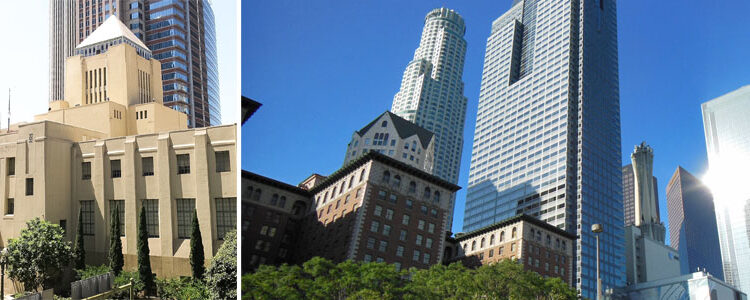
Transfer of Development Rights / Transfer of Floor Area Rights
What are TDR and TFAR programs?
Transfer of Development Rights (TDR) and Transfer of Floor Area Rights (TFAR) are economic incentive programs that help direct new development away from sensitive areas, including parcels containing historic resources. Property owners can quantify and sell unused development rights from their sites to other landowners, who can then increase the density of new construction in more appropriate locations.
What do TDR and TFAR programs mean for me?
TDR and TFAR programs help relieve market pressures from low and medium rise historic buildings by permanently removing their development potential. Rather than preventing new density, these programs are important mechanisms for smart growth, particularly in urban neighborhoods like downtown Los Angeles.
These types of programs make historic preservation more financially viable. In neighborhoods where new, dense construction is on the rise, property owners do not have to choose between preservation and profitability. In exchange, historic properties are permanently protected from demolition and redevelopment.
Background
Transfer of Development Rights (TDR) is a market-based tool that redirects development from historically or ecologically sensitive areas to more appropriate areas.
New York City adopted the first TDR program in the United States in 1968 as part of its Landmarks Preservation Law. Since then, more than two dozen jurisdictions have developed historic preservation TDR programs nationwide.
All TDR programs involve "senders," who voluntarily sell the development rights of a "sending parcel" to a "receiving parcel."
In places with high development pressures, TDRs disincentivize the demolition of historic buildings while supporting growth in more appropriate areas.
Downtown Los Angeles's Central Business District uses a type of TDR program called "Transfer of Floor Area Rights" (TFAR), which allows 'senders' to sell their floor area rights to 'receiving' parcels. The program began in 1975 and was amended in 1985 and 1988 to allow for larger transfers.
One of the program's most successful transactions was the transfer of $50 million worth of air rights from the Los Angeles Central Library to the US Bank Tower (then-Library Tower) across the street. The income enabled the City to invest in the rehabilitation of the historic library structure while granting the owners of the Library Tower the required development rights to construct a seventy-three story skyscraper.
In addition to floor area rights, some programs allow for the sale of height, housing units, or parking units.
The successes of the TFAR program in Los Angeles can be attributed to the underlying height district in Downtown's Central Business District. Because the base Floor Area Ratio (FAR) is set fairly low, there is a strong demand among developers for unused floor area.
Today the TFAR program is mainly a revenue generating program for the City, with the Convention Center and Staples Center selling the most floor area rights to developers. In the future, more proactive designation of historic structures as "sending parcels" could relieve development pressures from these properties and redirect them to more appropriate locations. New tools should be considered through Community Plan updates and the re:code LA initiative.
Currently, floor area transfers can be made between any two properties in the Central Business District, allowing increased density to enter historically sensitive neighborhoods such as the Historic Core. One possible solution would be to delineate "sending districts" and "receiving districts" within the Central Business District. This would ensure that development is directed away from areas with high concentrations of historic resources and into areas that can accommodate the growth.
Read more about the Conservancy's position on high rise development in Downtown Los Angeles >>